MXA RACE TEST | 2017 KTM 450SXF: NO NEED FOR NAME CALLING
Click on images to enlarge
Q: FIRST AND FOREMOST, IS THE 2017 KTM 450SXF BETTER THAN THE 2016 450SXF?
A: Yes, but for one reason and one reason alone—suspension. KTM has gotten the monkey off its back. KTM finally has forks that are worthy of the rest of the machine, and, as a bonus, they lowered the rear-shock spring rate to a much more consumer-friendly stiffness.
Q: DOES THE 2017 KTM 450SXF OBSOLETE ALL PREVIOUS 450SXFs?
A: Right off the bat, every current KTM 450SXF owner wants to know if the 2017 model obsoletes their trusty but rusty older model. The quick and dirty answer is no, but there are caveats.
(1) 2016 KTM 450SXF owners. For the most part, the 2017 KTM 450SXF is the 2016 KTM 450SXF. The WP AER air fork is the biggest difference, because it is 3.6 pounds lighter and light years better than the 4CS fork that came on the 2016 model. If, however, you have had your 4CS fork worked on to your satisfaction, you can easily be content living with your current scoot.
(2) 2016 KTM 450SXF Factory Edition owners. The 2016-1/2 450SXF Factory Edition came out in January of 2016, and for all intents and purposes, it was a pre-production version of the 2017 KTM 450SXF. There are some differences in fork valving, shock spring rate, and a few doodads that can be either retro-fitted or sourced from the aftermarket. 2016 Factory Edition owners have 95 percent of the 2017 model.
(3) 2015 KTM 450SXF owners. Break out the checkbook, because pre-2016 KTM 450SXFs don’t make as much horsepower, aren’t as ergonomically correct and weigh 10 pounds more. The bummer of upgrading from a 2015 model is that you don’t get to keep the orange frame.
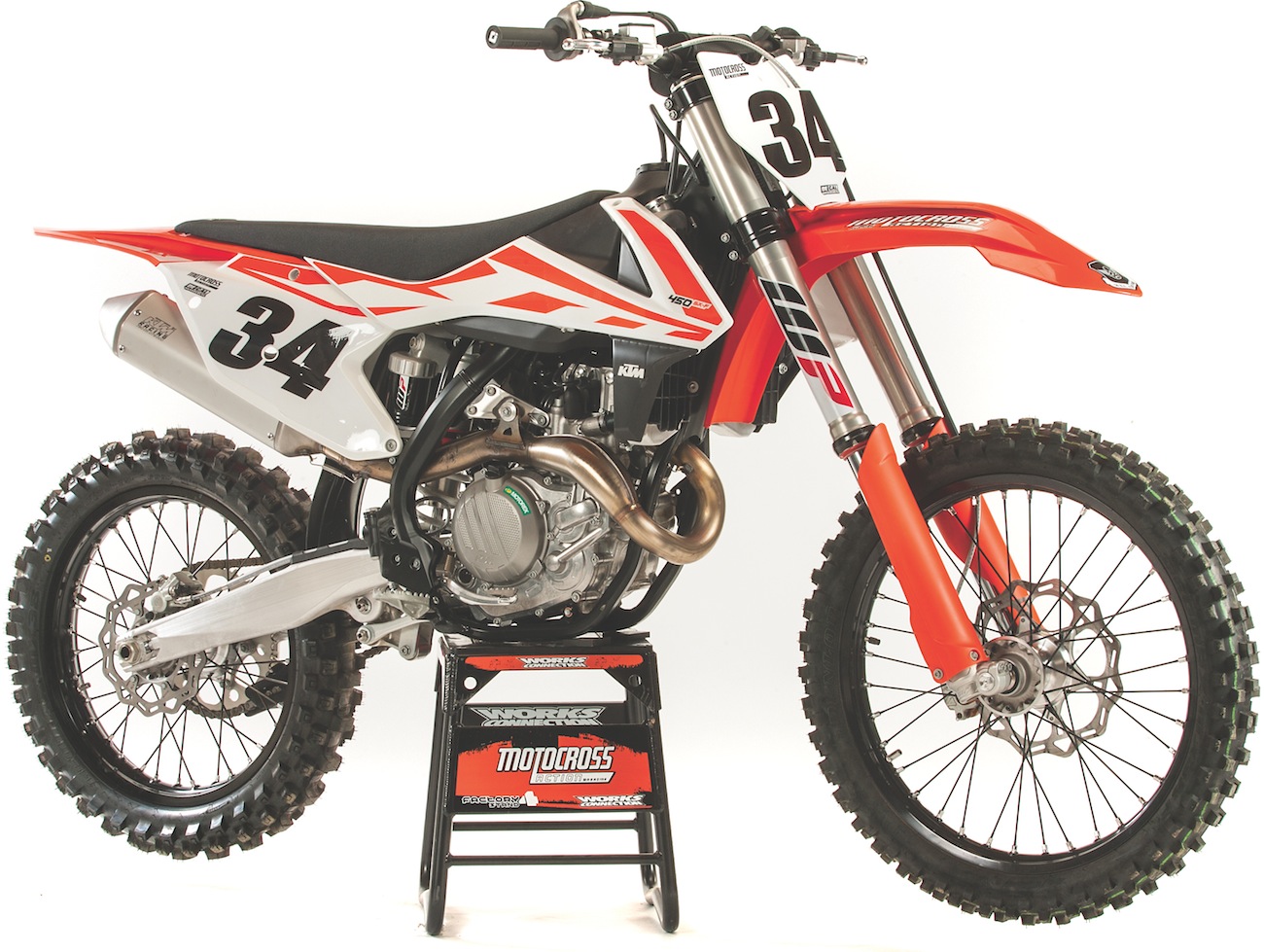 Totally new in 2016, KTM’s R&D dollars for 2017 went into suspension refinements. The WP forks used to be their worst feature, now it is their best.
Totally new in 2016, KTM’s R&D dollars for 2017 went into suspension refinements. The WP forks used to be their worst feature, now it is their best.
Q: WHAT CHANGES DID KTM MAKE TO THE 2017 450SXF?
A: The list of changes from 2016 to 2017 can be summed up in 11 bullet points.
(1) Air forks. WP AER front forks replace last year’s WP 4CS forks. Unlike Showa or Kayaba air forks, KTM’s units use a single air pressure (in one leg). The forks are the biggest contributor to KTM’s astonishing third year of weight loss in a row. KTM supplies a digital air pump with every bike.
(2) Triple clamp. The top triple clamp is more rigid in 2017 than it was in 2016. It is designed to mate better with the flex characteristics of the air fork. The difference is noticeable in that the machined hole in front of the steering-stem bolt has disappeared.
(3) Handlebar clamps. Last year the bars were mounted to a one-piece lower bar mount with two separate top bar-mount clamps. For 2017 the bottom bar mounts are now two separate pieces while the top bar mount is one piece. KTM says this will prevent twisting. We didn’t notice a lot of difference.
(4) Shock spring. Last year the 2016 KTM 450SXF and Factory Edition came with the 48 N/m shock spring. This spring was too stiff for anyone under 180 pounds. This year the 450SXF gets a more appropriate 45 N/m spring. In fact, every 2017 KTM motocross model will get lighter spring rates. The 350SXF, 250SXF and 250SX two-stroke will come with 42 N/m springs, while the 125SX and 150SX are spec’ed with 39 N/m springs.
(5) Map switch. Gone is the flick-style selector switch that toggled back and forth between two maps and activated launch control. In its place is a multi-switch on the left side of the bars that toggles between two maps, launch control and traction control.
(6) Traction control. New for 2017, KTM has added a traction-control feature to the electronic package on the KTM four-strokes.
(7) Brake pedal. The rear brake pedal is now 10mm longer than it was in 2016. Owners of 2016s can order a 10mm-long brake tip from 7602 Racing that does the same thing. Retail price is $34.95 at www.7602racing.com.
(8) Rear brake pads. For 2017 the rear brake pads have a less aggressive compound. Many racers felt that the previous rear brake pad was too grabby and could overheat if used too aggressively.
(9) Head stays. Last year’s steel head stays have been replaced with cast-aluminum stays that are 60 grams lighter than the steel they replace.
(10) Hour meter. There is an hour meter installed on every KTM 450SXF. It is located neatly behind the front number plate in the spot where the hole used to be in the top triple clamp.
(11) Damped Diaphragm Steel (DDS) clutch. KTM’s CNC-machined steel clutch basket with an integral primary gear has been lightened, while the inner hub and pressure plate have been modified to provide a better oil supply to the inner workings.
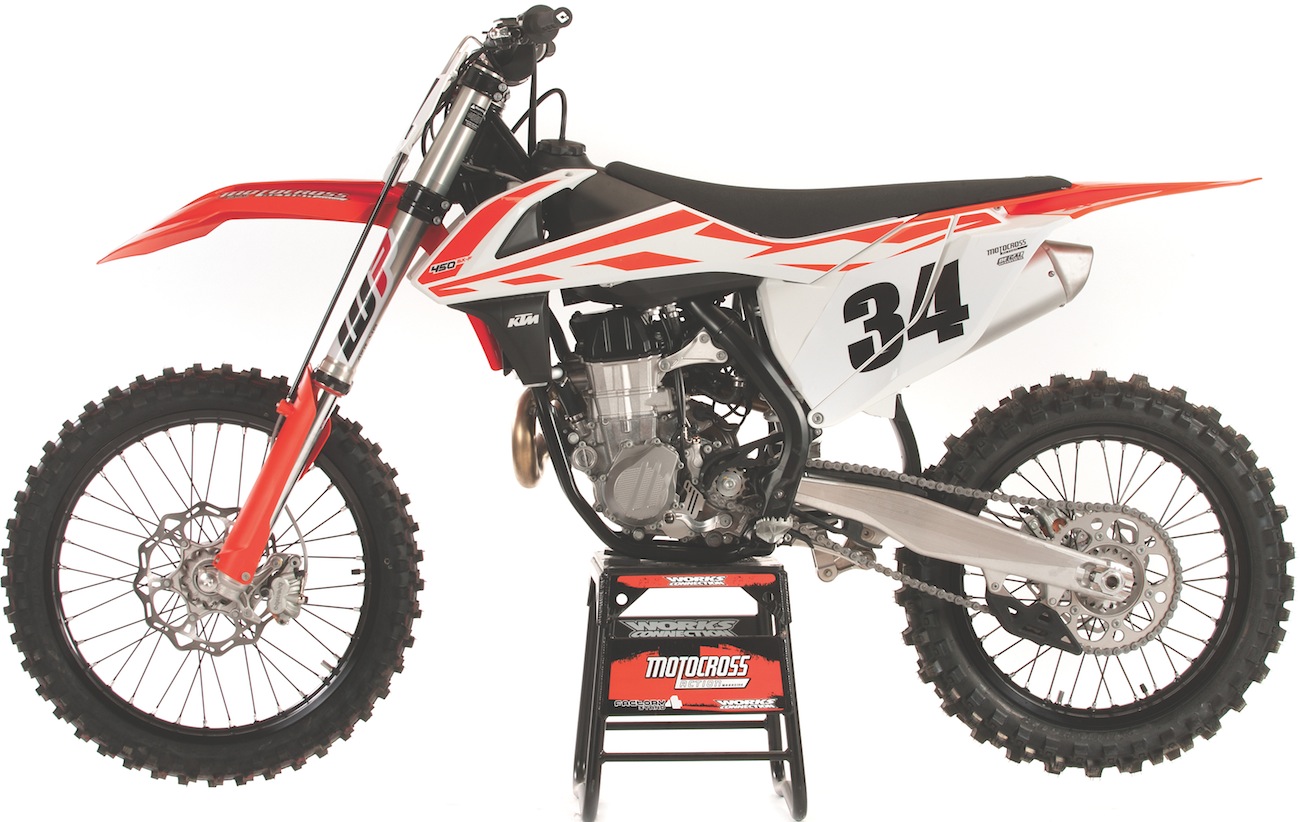 To keep up with KTM, the red, yellow, blue and green bikes would need to get down to 222 pounds with electric start, hydraulic clutch and 58 horsepower. That’s a big task.
To keep up with KTM, the red, yellow, blue and green bikes would need to get down to 222 pounds with electric start, hydraulic clutch and 58 horsepower. That’s a big task.
Q: HOW GOOD IS THE 2017 KTM 450SXF?
A: We don’t want to give the performance of the 2017 KTM 450SXF short shrift, but we have bigger fish to fry on the 2017 KTM 450SXF. Suffice it to say that the powerband, transmission, clutch and handling of the 2017 KTM are spitting images of the 2016 KTM 450SXF. They are all great, best in class, head and shoulders above the offerings of the green, red, yellow and blue bikes. Here are the Cliff Notes.
Powerband. The KTM 450SXF’s powerband pulls longer than any other engine on the track. It comes out of the gate in second and just keeps churning. At over 58 horsepower, it is no slouch, but it’s not the amount of power that the 450SXF engine makes; instead, it is the luscious, long, optimally usable power that draws the rave reviews. This is a different kind of power from what the other brands offer. It doesn’t blast power as much as it oozes it.
Transmission. The five-speed gear box is bulletproof. Thanks to a slightly raised shift lever, if this bike misses a shift, it’s probably your fault. Once at speed the power is still supremely manageable. It’s not white-knuckle fast, it’s not frightening, it’s doesn’t hit too hard or rip your arm out of their sockets —it just goes. And, if the brakes weren’t so great, everything from your eyeballs to your toes would pucker up as you rocketed into turns.
Clutch. There are people who don’t like the feel of hydraulic clutches, but KTM’s DDS clutch goes way beyond personal taste. Its steel clutch basket can never get notchy. The Belleville washer offers even pressure across the complete clutch pack. Riders who burn up KX450F, CRF450 or RM-Z450 clutches in one or two motos will go months on KTM’s plates. This is a clutch designed for the ham-fisted among us. You can’t hurt it.
Handling. This is the best all-around-handling bike on the track. It handles instinctively. You just have to think about choosing a line and it takes it.
 There is peak horsepower to be found in aftermarket pipes, but the stocker delivers extremely usable power.
There is peak horsepower to be found in aftermarket pipes, but the stocker delivers extremely usable power.
Q: HOW GOOD ARE THE 2017 WP AER FORKS?
A: The most important aspect of any KTM is its forks. WP forks have been the weak link in KTM’s almost-flawless chain for decades. The only people who don’t know that work at WP. But, finally, the engineers at WP put their thinking caps on and hit the jackpot with the 48mm AER air forks. Even a blind squirrel finds a set of forks that don’t chatter like false teeth in the braking bumps every 20 years or so. And so it is with WP.
How good are the 2016 WP forks? So much better than what WP offered in the past that it’s not enough to say that they are improved, because they are so much more than that. WP’s take on air forks is so unique that its forks share very little with other air forks on the market. These forks are ingenious in their simplicity. Only the left leg is charged with air, and that air is contained in a sealed cartridge. Unlike PSF’s or TAC’s additional balance chamber, the WP AER fork works on the same recycled-gas principles as a rifle. The AER fork uses the compressed air that is generated from fork movement to dampen the fork on its return stroke. And, it does this with no added moving parts. When the 34mm sealed-cartridge rod’s piston goes by a two-way bypass, the air pressure in the upstroke becomes the air pressure in the downstroke. Thus, in one up-and-down movement, WP is able to use the same air pressure in two different directions. The damping is in the right fork leg and consists of 36 adjustable clicks of compression (on the fork cap) and 36 rebound clicks (under the fork leg).
Although last year’s 4CS fork had acceptable performance for Novice and Vet riders, it was unusable by fast Intermediates or Pros. It bottomed, chattered and moved so rapidly in the mid-stroke that the damping was ineffective. No more! We think that for the local racer KTM’s AER air forks are the best iteration of air technology on the track. Not just because they work well, but because they are easy to live with. The air spring is simple to adjust to any rider weight via a single air valve. There are no special tools or knowledge required; just pump them up and forget them. The right fork leg handles the damping and can be adjusted to track conditions without having to go to the App Store for guidance. You can race these forks right off the showroom floor.
Q: WHAT ABOUT THE REAR SHOCK?
A: In our minds, KTM’s rear shock has never been the problem. The trouble came from the forks. When the forks don’t work, the shock can’t work. Previous WP forks were too soft initially and too harsh at the end of the stroke. When the fork travel came to a screeching halt against WP’s wall of damping, the excess forces would rotate through the axis of the frame and make the shock kick. Now that the AER air forks absorb energy, the shock doesn’t take the brunt of every bump. As a result, the rear end of the KTM 450SXF feels better. KTM did re-valve the shock and lighten the spring rate to make the shock work better, but in truth, all credit goes to the fork.
Q: HOW DOES KTM’S MAP SWITCH WORK?
A: Unlike last year’s map switch, which was on the right side of the handlebars and allowed you to choose between two of three possible ignition timing maps, with one map always being stock and the second map being labeled mellow, aggressive or stock on a dial inside the airbox, the 2017 map switch only has two map choices. When you press the rubber-covered button on the bottom of the multi-switch, a lighted number is displayed on the face of the multi-switch. Number one is stock and number two is aggressive. Every MXA test rider chose to run the aggressive map because it produced quicker throttle response and helped jump the power up to the midrange where it does its best work. There is no dial in the airbox to bother with, and by the same token, there is no mellow map option.
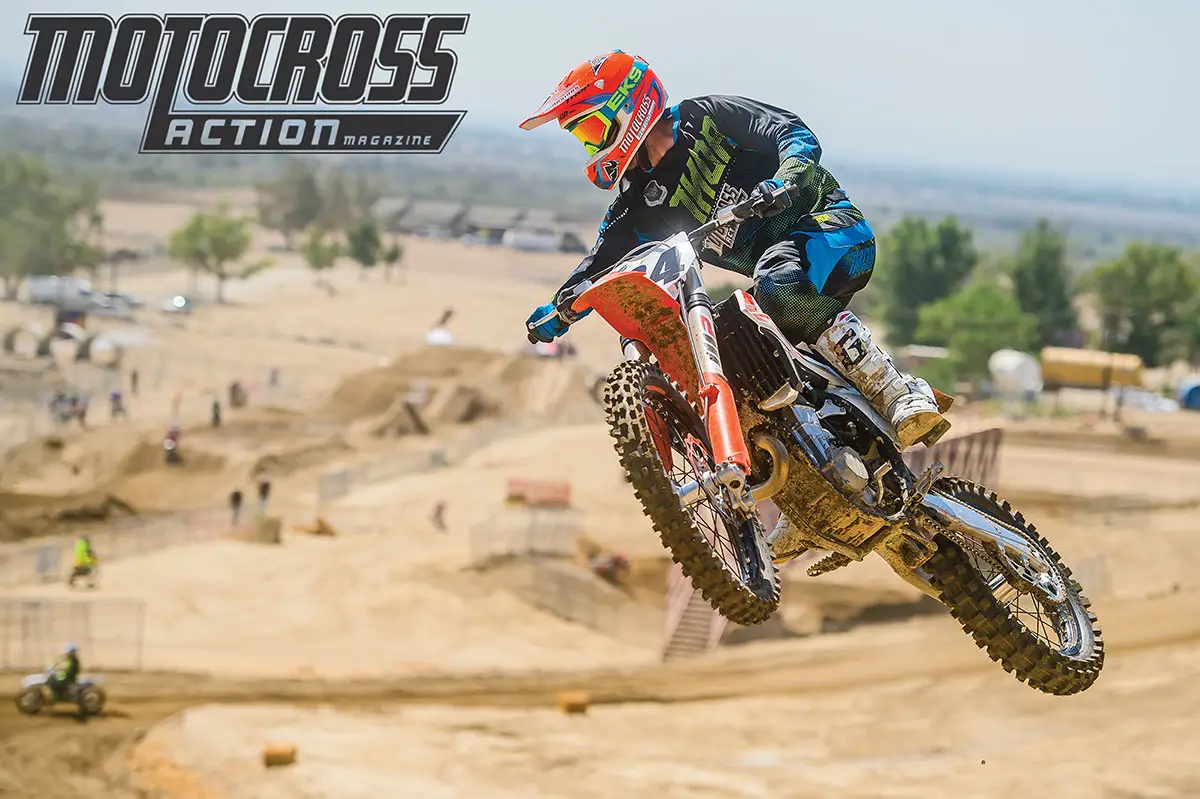
Q: HOW DOES KTM’S TRACTION CONTROL SWITCH WORK?
A: After you have selected between the two maps, you can elect to run traction control. Traction control has been illegal in AMA Pro racing for most of the last 30 years, but in 2015 the AMA changed the rule to read: “Non-production electronic devices designed specifically for traction control are prohibited.” After decades of banning traction control while doing absolutely nothing to enforce the rule in the face of escalating electronic ignition controls, the rule makers quietly slipped the word “non-production” into the rule. Surprise! The 2015 Kawasaki KX450F was the first bike to advertise that it came with traction control as one of its new highlights. No big deal. Honda put the same type of traction control on the 1997 Honda CR250 and the AMA never made a peep. If you read the rule closely, you can see that aftermarket traction control, like the GET system, is still illegal. Yet, virtually every factory bike at an AMA National has GET’s system on it. Any bets on them getting busted? Naw, didn’t think so.
Modern traction control works by having the ECU monitor runaway revs. Runaway revs are an indicator that the engine is free-revving, which means that the rear wheel is spinning. To stop the wheel from spinning, the ECU retards the ignition to slow the engine down and gets the wheel hooked up again. How fast does this happen? Back in 1997, Honda’s system monitored revs every 1/35th of a second. We don’t know how quickly the KTM monitors runaway revs, but suffice it to say that modern computer control units are more powerful than they were 30 years ago.
To engage KTM’s traction control system, press the rubber-covered button on the top of the multi-switch and the letters “TC” will light up in the window. As long as TC is showing, the KTM 450SXF is functioning with traction control. The MXA test riders only used the KTM traction control switch in places where they used last year’s mellow map. We found that when we engaged the system on a loamy track, it was a massive distraction and of little or no value. Thus, don’t think of TC as anything remotely resembling factory-level traction control systems but more like a third ignition map to use on hard-packed dirt or mud.
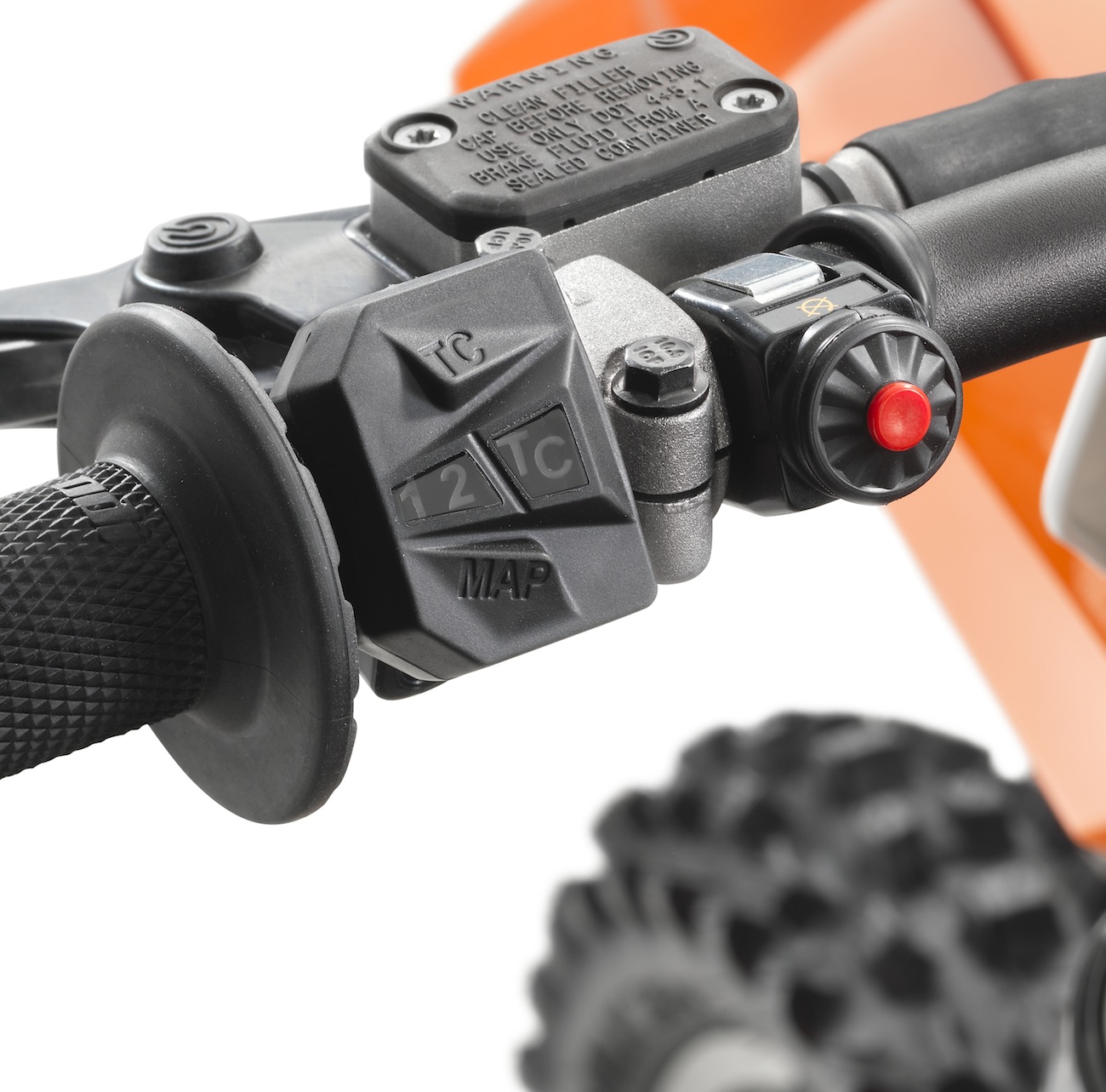 KTM’s multi-switch handles maps, traction control and launch control, but there is a learning curve to using it.
KTM’s multi-switch handles maps, traction control and launch control, but there is a learning curve to using it.
Q: HOW DOES KTM’S LAUNCH CONTROL SWITCH WORK?
A: Last year a rider had to cycle the flip switch on the right side of the bars back and forth until the indicator light behind the front number plate flashed. For 2017 the rider has to press the rubber-covered map button and the traction control button simultaneously until the indicator light behind the front number plate flashes. This is easy to do with gloved hands or if the gate is getting ready to drop. You have to plan ahead because it takes two hands. Of supreme importance is that once launch control is engaged, you must refrain from blipping the throttle. If you rev the engine up and let the revs fall by more than 30 percent, launch control will shut off—and you cannot reengage it without shutting the engine off.
MXA test riders rarely use launch control on dirt starts, but we use it all the time on concrete. Everybody has his own method for using launch control off the line, but the majority of MXA test riders hold the throttle wide open and dump the clutch. The retarded ignition curve knocks off several horsepower to decrease the chance of wheelspin. You should practice starts to find out how much throttle works best for you.
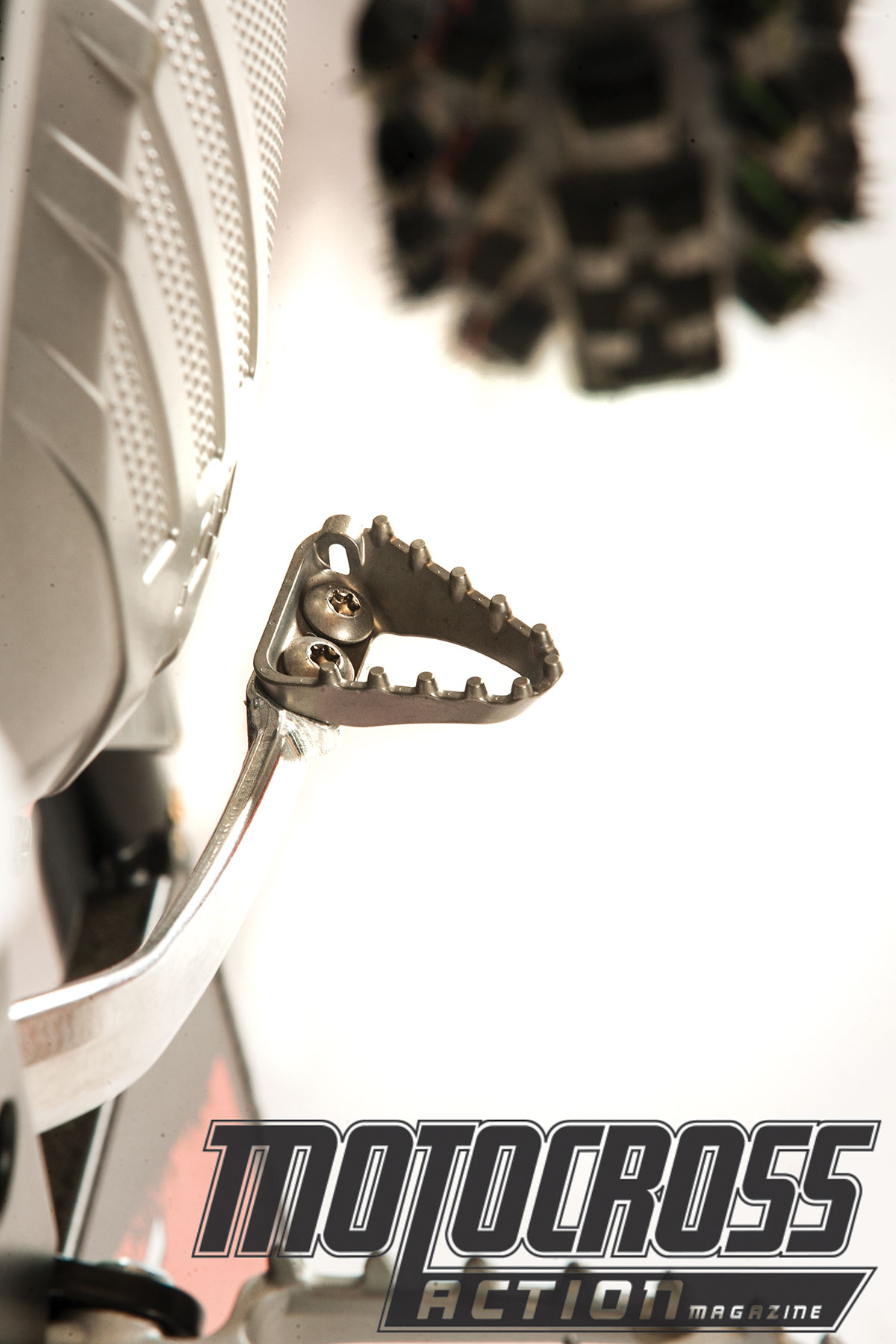
Q: WHAT DID WE HATE?
A: The hate list:
(1) Gas cap. It sticks. Take a body-building class; you’ll need it at some point.
(2) Fork air bleeder. Even if you own a #20 Torx wrench, never use it on the air side of the WP forks. It will strip out. Just use a 10mm T-handle. On the left side, you have to use the #20 Torx, but at least this screw is made from steel. On the left side we replaced the Torx with the Phillips head screws from a previous model.
(3) ODI grips. Oh, don’t get us wrong, we like the ODI lock-on grips, but the clutch side is locked on with a #15 Torx. Yeah, we don’t own one of those either.
(4) The pipe. You can’t take the pipe off the bike without removing the shock or the swingarm. Take your pick.
(5) Sprocket bolts. Watch them for as long as you own the bike.
(6) Spokes. Always check the spoke next to the rear rim lock. If it is loose—and five times out of ten it will be—tighten all the spokes.
(7) Neutral. We love how well the KTM shifts from gear to gear but hate how hard it is to get into neutral when standing still.
(8) Bike stand. When the bike is sitting on a bike stand, the front wheel is on the ground. This is a hassle when checking the spokes or working on the front end.
(9) Front brake hose. Be very careful when hooking tie-downs onto your handlebars that they don’t crimp the L-bend tube coming out of the front brake’s master cylinder. We would prefer more room between the brake line and the bars to lessen the chance of damage.
(10) Cold weather starting. On cold mornings you need to preheat the battery to build up its voltage. You do this bu presser the starter button just briefly enough to get the fuel pump to run. This has to be done three or four time, with a 30 second pasue between attempts. Once the battery warms up, the bike will start with the choke on (and remember the choke is on when you push it up, not pull it down)
Q: WHAT DID WE LIKE?
A: The like list:
(1) Weight. We were impressed that the 2016 bike weighed 227 pounds and are equally impressed that the 2017 KTM 450SXF now weighs 222 pounds.
(2) Powerband. The 2017 KTM 450SXF proves that powerful engines don’t need to be detuned to make them easy to ride. The KTM 450SXF has the perfect powerband for riders from Beginners to National Champions.
(3) Tires. We run Dunlop MX3S intermediate tires on our race bikes, so the fact that KTMs come stock with them just makes life easier for the MXA test crew; however, the front knobs on an MX3S will tear off if you run it on hard-packed dirt. The rear is a 120 width, and once it wears out, we switch back to a 110, especially for tracks with ruts and flat sweepers.
(4) Value added. This is the lightest and most powerful 450 made. It achieves this even though it has an electric starter. The bike’s 222-pound weight, hydraulic clutch, innovative air filter and workable air forks make it a winner on the track.
(5) Hydraulic clutch. This clutch is stout enough to last a full race season without being touched. If you are clutch abuser, you won’t pay the price in burned up clutch plates with the KTM clutch.
(6) Handling. You don’t have to point it where you want it to go; you just have to think it.
(7) Hour meter. Kudos to KTM for putting an hour meter on its bikes at the factory — and saving us the trouble.
Q: WHAT DO WE REALLY THINK?
A: If you have a wish list of 450cc motocross bikes that you’re choosing between and the 2017 KTM 450SXF isn’t at the top of the list, then you, sir, are an idiot.
MXA’S KTM 450SXF SETUP SPECS
This is how we set up our 2017 KTM 450SXF for racing. We offer it as a guide to help you find your own sweet spot.
AER FORK SETTINGS
The trick to getting the most from your AER air forks is to find the proper air pressure for your weight, speed and track. We typically start with the OEM recommended air pressure and then lower it in 2-psi increments. How do we know when we have the proper pressure? We lower the air pressure to the point where the forks don’t feel like they are dropping into their stroke without bottoming. Typically, they ride high in their stroke with the stock pressure. For hard-core racing we recommend this fork setup on the 2017 KTM 450SXF (stock specs are in parentheses).
Spring rate: 135 psi (Novice), 145 psi (Intermediate), 150 psi (Expert)
Compression: 15 clicks out
Rebound: 15 clicks out
Fork-leg height: Third line
Notes: Slower or lighter riders might have to lower oil height in the damping leg by 10mm or more to get full travel. Additionally, the air pressure goes up as the ambient temperature rises. In these cases, just reset the air pressure to your chosen setting. It should be noted that if you ride long moto, the air pressure will rise by 4 psi because of internal friction. We bleed the outer chamber regularly, which is accessed via an 10mm hex head or #20 Torx. Even if you own a #20 Torx, don’t use it, because it strips out easily. Don’t be afraid to go down on the air pressure, using a zip-tie on the fork leg to see how much travel you are getting. We have riders who run as low as 135 psi. Once you find the air pressure for you, use the clickers to dial in the fee.
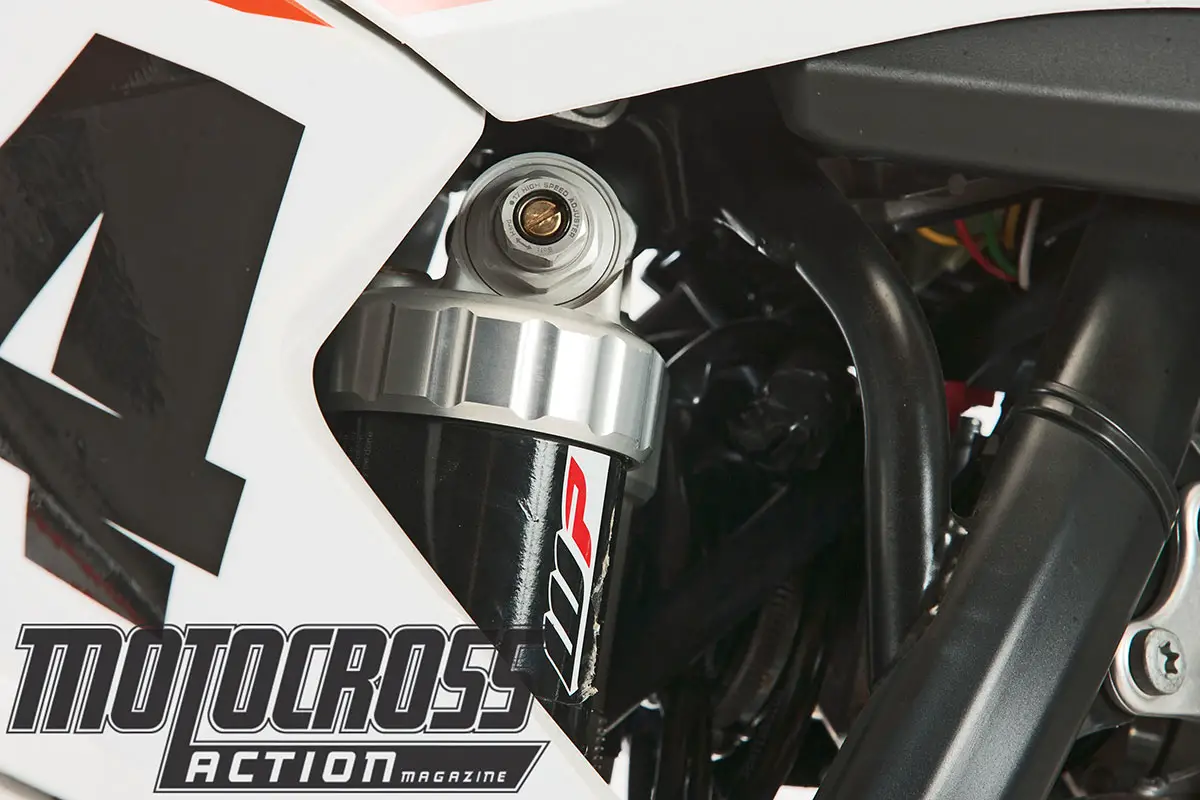
WP SHOCK SETTINGS
Last year the KTM 450SXF came with a very stiff 48 N/m shock spring. Many riders had trouble getting any preload on the 48 shock spring. MXA swapped all of our 48 N/m springs for the lighter 45 N/m spring from the 250SXF. For 2017 KTM is lowering all of its motocross bike spring rates, which means that the 2017 450SXF has a 45 N/m spring. If you are around 200 pounds, you will probably want to return to the 48 N/m spring. For hardcore racing, we recommend this shock setup for the 2017 KTM 450SXF (stock specs are in parentheses).
Spring rate: 45 N/m
Race sag: 105mm (110mm)
Hi-compression: 1-3/4 turns out (2 turns out)
Lo-compression: 15 clicks out
Rebound: 10 clicks out (15 clicks out)
Notes: We turned the high-speed compression damping in a little to lessen G-outs and ran a touch more rebound than the recommended setting. Additionally, we set the sag at 105mm instead of the WP-recommended 110mm.





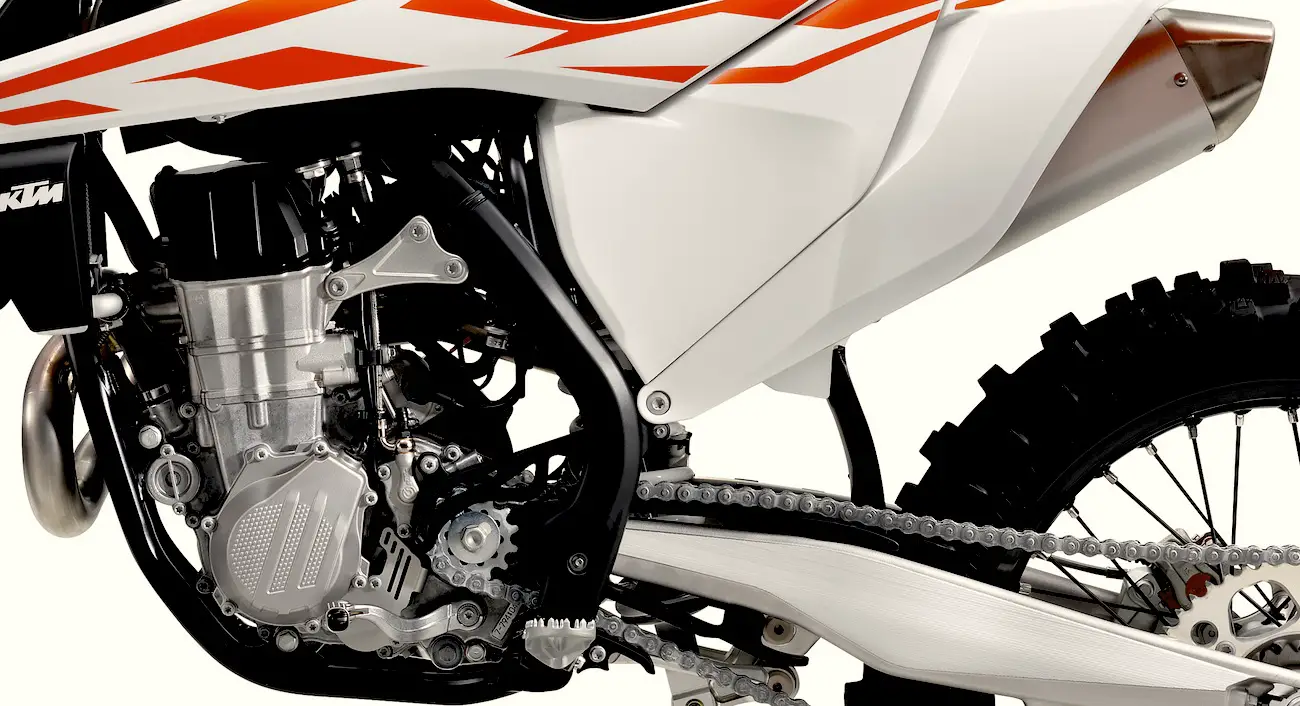

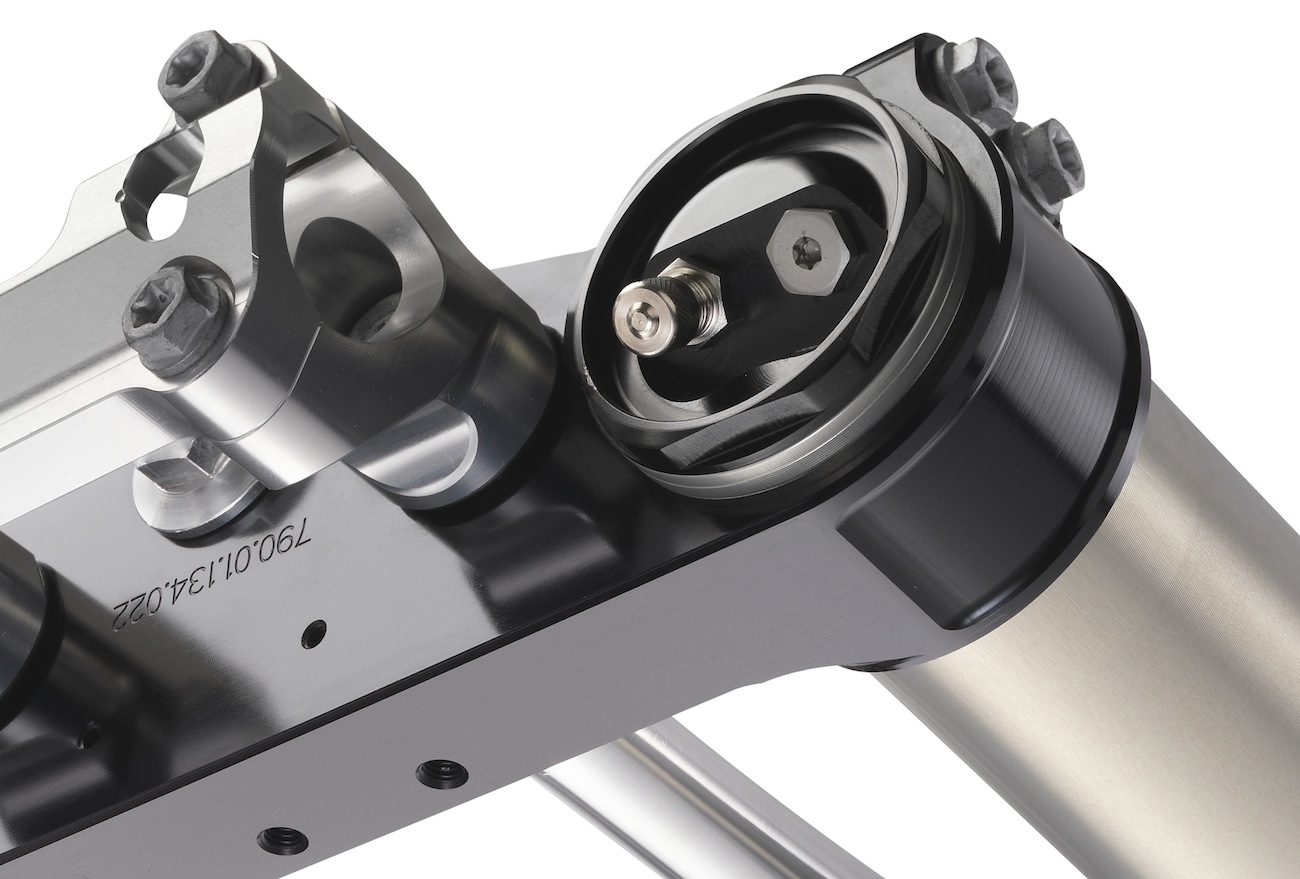



Comments are closed.